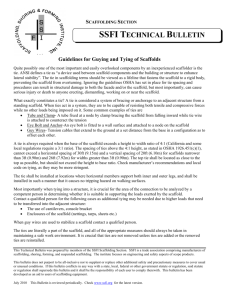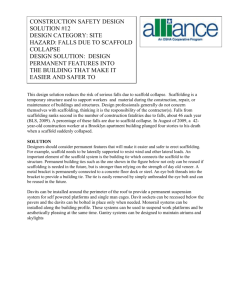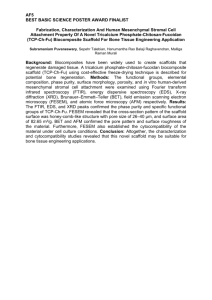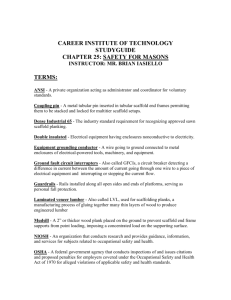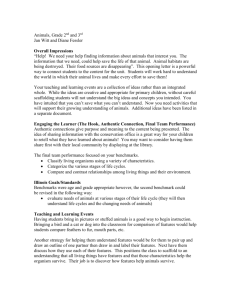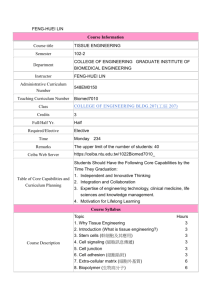Importance of Baseplates
advertisement
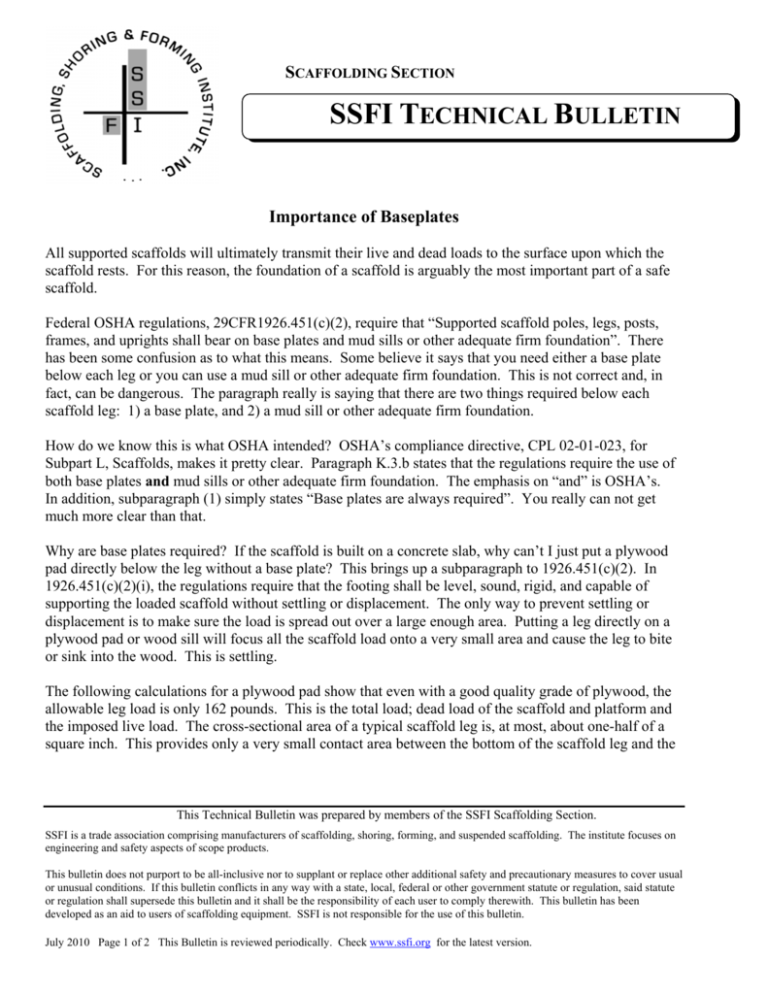
SCAFFOLDING SECTION SSFI TECHNICAL BULLETIN Importance of Baseplates All supported scaffolds will ultimately transmit their live and dead loads to the surface upon which the scaffold rests. For this reason, the foundation of a scaffold is arguably the most important part of a safe scaffold. Federal OSHA regulations, 29CFR1926.451(c)(2), require that “Supported scaffold poles, legs, posts, frames, and uprights shall bear on base plates and mud sills or other adequate firm foundation”. There has been some confusion as to what this means. Some believe it says that you need either a base plate below each leg or you can use a mud sill or other adequate firm foundation. This is not correct and, in fact, can be dangerous. The paragraph really is saying that there are two things required below each scaffold leg: 1) a base plate, and 2) a mud sill or other adequate firm foundation. How do we know this is what OSHA intended? OSHA’s compliance directive, CPL 02-01-023, for Subpart L, Scaffolds, makes it pretty clear. Paragraph K.3.b states that the regulations require the use of both base plates and mud sills or other adequate firm foundation. The emphasis on “and” is OSHA’s. In addition, subparagraph (1) simply states “Base plates are always required”. You really can not get much more clear than that. Why are base plates required? If the scaffold is built on a concrete slab, why can’t I just put a plywood pad directly below the leg without a base plate? This brings up a subparagraph to 1926.451(c)(2). In 1926.451(c)(2)(i), the regulations require that the footing shall be level, sound, rigid, and capable of supporting the loaded scaffold without settling or displacement. The only way to prevent settling or displacement is to make sure the load is spread out over a large enough area. Putting a leg directly on a plywood pad or wood sill will focus all the scaffold load onto a very small area and cause the leg to bite or sink into the wood. This is settling. The following calculations for a plywood pad show that even with a good quality grade of plywood, the allowable leg load is only 162 pounds. This is the total load; dead load of the scaffold and platform and the imposed live load. The cross-sectional area of a typical scaffold leg is, at most, about one-half of a square inch. This provides only a very small contact area between the bottom of the scaffold leg and the This Technical Bulletin was prepared by members of the SSFI Scaffolding Section. SSFI is a trade association comprising manufacturers of scaffolding, shoring, forming, and suspended scaffolding. The institute focuses on engineering and safety aspects of scope products. This bulletin does not purport to be all-inclusive nor to supplant or replace other additional safety and precautionary measures to cover usual or unusual conditions. If this bulletin conflicts in any way with a state, local, federal or other government statute or regulation, said statute or regulation shall supersede this bulletin and it shall be the responsibility of each user to comply therewith. This bulletin has been developed as an aid to users of scaffolding equipment. SSFI is not responsible for the use of this bulletin. July 2010 Page 1 of 2 This Bulletin is reviewed periodically. Check www.ssfi.org for the latest version. plywood. The leg will crush the wood fibers and cut into the plywood creating an indentation. Using a base plate will distribute the leg load to a much larger area, typically about 6” by 6”, or 36 square inches. Placing a scaffold leg directly onto a concrete slab is also not allowed. The compressive strength of concrete is generally in the 3000 – 5000 psi range. Using an average of 4000 psi, the allowable load capacity of a scaffold leg on concrete would be 4000 x 0.476 = 1904 pounds. While this is much greater than a scaffold leg on plywood, it is still less than the typical capacities of scaffold legs. Always use base plates or screw jacks with base plates on all scaffolds. Scaffolds built on concrete slabs will generally not need a sill but scaffolds built on the ground (whether asphalt, grass, backfill, etc) will require a mud sill. How big must the mud sill be? Large enough to support the scaffold load without settling. Check with a qualified person if necessary. Plywood Calculations Assume APA Marine Exterior Plywood Veneer Grade A Grade Stress Level 1 Species Group 1 PLYWOOD SCAFFOLD LEG From APA Plywood Design Specification: Bearing (on face perpendicular to plane of plies) Fc┴ = 340 psi (dry) 210 psi (wet) Scaffold Leg Area: Tube OD = 1.69” Wall Thickness = 0.095” Tube ID = 1.50” Area A = (D2 – d2) 3.14 / 4 = (1.692 – 1.52) 3.14 / 4 = 0.476 sq. in. Maximum Allowable Load on Plywood: PDRY = 340 x 0.476 = 162# PWET = 210 x 0.476 = 100# This Technical Bulletin was prepared by members of the SSFI Scaffolding Section. July 2010 Page 2 of 2 This Bulletin is reviewed periodically. Check www.ssfi.org for the latest version.


